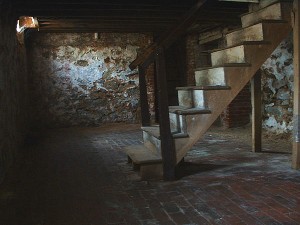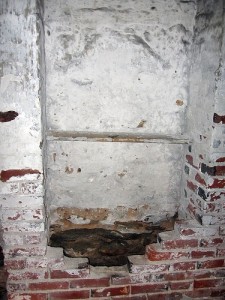
In The Black Cat, the psychotic narrator slaughters his wife with an axe after she stops him from killing the phantasm of a cat he feels is tormenting him. He conceals her body in a brick wall in the cellar. He brazenly invites the police down to the cellar for inspection, smugly confident in his own safety. A hideous wailing fills the cellar and the officer tears down the wall to find his wife’s rotting corpse with the shrieking cat perched on her head. ” I had walled the monster up within the tomb!”
The Black Cat describes the home’s actual basement in eerie detail. It’s barren and clammy, floorboards agroaning, peeling paint, cold brick maws, echoey and dolorous. At the bottom of the the stairs is a half bricked, false chimney where the wife’s bludgeoned body would have been hidden. “By means of a crow-bar I easily dislodged the bricks, and, having carefully deposited the body against the inner wall, I propped it in that position, while, with little trouble, I re-laid the whole structure as it originally stood. Having procured mortar, sand, and hair, with every possible precaution, I prepared a plaster could not every poss be distinguished from the old, and with this I very carefully went over the new brick-work”.
I’m happy to report that even though the completely appropriate horror and grotesquery that the pre-restoration incarnation elicited is no more, the house where Poe didn’t write The Raven is still pretty ghastly. As well it ought to be.


